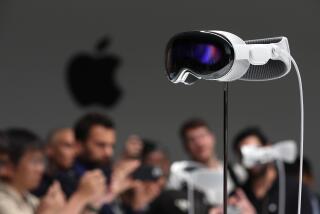‘Augmented reality’ poised to become an everyday reality for consumers
“Augmented reality” may sound like indecipherable technobabble, but the concept behind this technology is familiar to anyone who has seen any of the “Terminator” movies.
In the sci-fi films, a cyborg is able to scan its surrounding area and superimpose data on what it sees, which allows it to get background information on humans. Now, after years of use in academic and industrial circles -- not to mention science fiction -- augmented reality is coming to consumers, who can expect to see it in their everyday lives in 2010.
The technology overlays computer data on the real world as viewed through a live video feed. Consumers can see the early results of mainstream augmented reality in entertainment, interactive shopping experiences, magazines and even mobile phone applications. As a promotion for the movie “Coraline” this year, pedestrians who stopped in front of special window displays saw their reflections with their eyes transformed into buttons.
But this year was a “real tipping point” for augmented reality, said Greg Davis, general manager for North America at Total Immersion. “We’ve seen it proliferate onto multiple screens, computers and mobile screens, in home and out of home.”
This year Total Immersion created baseball trading cards for Topps Co. that when held in front of a webcam make a three-dimensional avatar of the player appear on-screen. It also designed product tie-ins for the film “Avatar” for McDonald’s Corp. and Mattel Inc., with technology embedded in Big Mac packages and action figures that makes animated 3-D landscapes and characters come to life when scanned by a webcam.
These consumer-oriented applications are possible because webcams are a standard feature of most new desktop and laptop computers. The software in the applications also works with current Web browsers and does not require a cumbersome download.
The next wave of programs probably will be for smart phones. The growth in third-party applications for mobile software platforms such as Apple Inc.’s iPhone system and Google Inc.’s Android means independent developers can experiment with augmented reality.
“You’ve not got just whatever Nokia and others can dream up, but potentially thousands of people thinking, ‘What can I do with this?’ ” said Jackie Fenn, vice president and research fellow at Gartner. “In the same way we had a flurry of innovation around Google Maps and things you can do with that, we’ll get a similar flood of innovation in these applications over the next year.”
Yelp launched an augmented-reality application for the iPhone 3GS this year called Monocle. When a user holds a phone’s camera to view a city street, information about nearby businesses pops up on the screen.
Yelp developers started working on Monocle after the launch of the newest iPhone, which had the compass, camera, large display and other features necessary to handle the application.
“We’ve learned that it’s really hard to do this well,” said Yelp product manager Eric Singley. “A lot of people are jumping into the game. They find there’s a level of polish that needs to happen . . . otherwise, it’s confusing, messy and jarring.”
Even with the anticipated push into mobile applications, industry experts say augmented-reality technology still has much room to grow in personal computers.
“We’re focused online right now,” said Matthew Szymczyk, chief executive of interactive marketing agency Zugara. “We’ve been looking at mobile, and we just don’t think it’s mature enough, though that is eventually where we think most augmented reality will be down the line.”
Industry players say a next step for augmented reality is greater interactivity. David Selinger, CEO of RichRelevance, which helped Zugara develop a shopping application called Fashionista, said enabling two webcams would allow people in different places to model outfits for each other.
Enhanced interaction also would benefit business uses of augmented reality, such as videoconferencing technology.
“People don’t want to take turns showing data but rather show data on the same virtual document that lets them point and annotate,” said Charles Stucki, vice president and general manager of Cisco’s Telepresence videoconferencing business unit. “One of the key things we see coming is the ability for people in these rooms to manipulate, annotate and share [data], and then set it to the side and keep working.”






